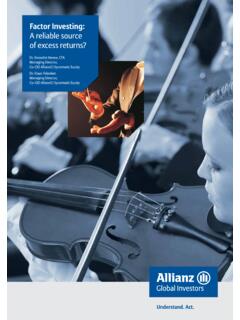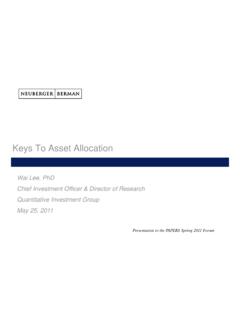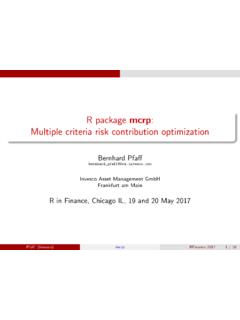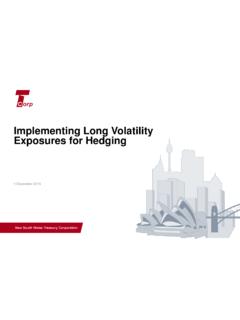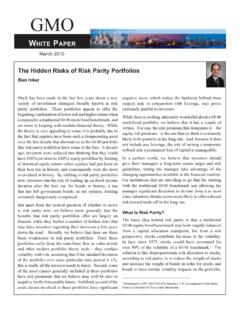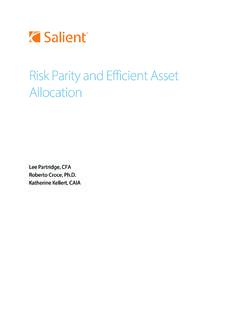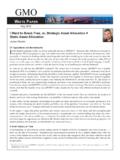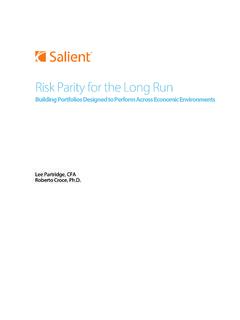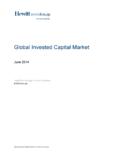Transcription of Liquidity Shock: The Hidden Risk in Modern Markets
1 Introduction Post-crisis changes to regulations and market structure have combined with innovations in technology and financial products to make global Markets more robust and efficient. Despite this progress, today s Markets still contain risks that increase vulnerability to volatility spikes, episodic disappearances of Liquidity and, potentially, another Liquidity crisis. The main sources of these risks are the ongoing stream of financial product innovations, automated and algorithmic trading practices and, ironically, some of the very regulatory adjustments put in place to strengthen Markets after the 2008 crisis. Together, these factors have the potential to turn a small market disruption into a rapid collapse of asset prices a danger that became all too real to investors during the sudden and dramatic reappearance of market volatility in February 2018. Over the coming decade, these risks could be exacerbated by unprecedented quantitative tightening by central banks that could cause funding Liquidity and, ultimately, market Liquidity to shrink.
2 Exhibit 1 (next page) illustrates how complex interactions among this web of factors could be making Markets more accident prone. Institutional investors who fail to account for resulting potential Liquidity shortages in their risk management practices are likely to find themselves in the dangerous position of having to scramble for Liquidity in disorderly Markets to protect against losses or meet regulatory this paper , we identify and assess the factors contributing to Liquidity risk and provide recommendations on how institutional investors can protect their portfolios from future Liquidity shocks. Key Takeaways Today s Markets contain Hidden risks that increase vulnerability to volatility spikes and Liquidity shortages. The main sources of these risks are financial product innovations, automated and algorithmic trading practices and regulatory adjustments put in place to strengthen Markets after the 2008 crisis. Also contributing to more accident prone Markets are diminished bank bond inventories, the growth of high-frequency trading, and the proliferation of ETFs and rules-based trading strategies.
3 These risks could be exacerbated in coming years by unprecedented quantitative tightening by central banks. Institutional investors should act now to account for potential Liquidity shortages in their risk management practices. Protecting a portfolio against Liquidity shocks requires a system to identify early or predictive signs of a shock and palliative actions in case a Liquidity shock occurs. Congress and regulators should work together to put in place micro- and macro-prudential measures that can minimize risks to Liquidity availability, help build investor confidence and, potentially, soften Liquidity Malin, PhD DirectorSenior Investment Strategist Global Economics & StrategyLiquidity Shock: The Hidden Risk in Modern MarketsInvestment IntelligenceM ar ch 2018 Massive high-beta Long-bias in disguise Hot money flowsShort volatility and trend-chasing crowding in private passive flowsIllusory diversification Illusory liquidityUnstable Equilibrium:a state in which a small disturbance produces a large change2 Liquidity Shock.
4 The Hidden Risk in Modern MarketsAs the financial system strengthened, Markets became more liquid During the Great Financial Crisis of 2008, Liquidity shrank dramatically or dried up entirely in the LIBOR, repurchase agreement, short-term commercial paper and other large-volume money Markets . The cost of short-term money soared as perceptions of counterparty risk became more acute. Illiquidity in the funding Markets spread to the capital Markets , which became unstable. Price discovery became difficult, if not impossible, as counterparties sought safety in cash. In response, financial market participants, regulators and central banks, especially, took powerful steps to make the banking and financial systems more resilient and assuage fears that funding Liquidity would become unavailable or unaffordable. These steps changed the financial landscape the midst of the crisis, monetary authorities were forced to step in to assure that illiquidity in specific funding Markets did not lead to sequential disruptions that would make the entire financial system inoperable.
5 These actions proved highly effective. Unconventional monetary policies drove interest rates to unprecedented low levels that sustained a recovery in real economic growth and accommodated lengthy bull Markets in both stocks and bonds. As Randal Quarles, the US Federal Reserve s Vice Chairman for Supervision, put it in a January 2018 address to the American Bar Association Banking Law Committee, new regulations and their enforcement resulted in critical gains to our financial system: Higher and better quality capital, an innovative stress testing regime, new Liquidity regulation, and improvements in the resolvability of large firms. Stress tests as well as multilateral accords that increased banks risk-based capital requirements and limited the amount of leverage banks can take on provided a buffer against credit-related losses, while new laws like Dodd-Frank created a new, deeper source of Liquidity in the form of a modernized swaps the crisis, Markets have also been made more efficient mechanically by technological advances and product innovations.
6 Trades are executed nearly instantaneously worldwide at transaction costs that are a small fraction of what they were a few decades ago. Fixed-income Markets , especially, have been transformed as barriers to entry have fallen and new Liquidity providers have stepped forward. Electronic trading platforms, post-trade infrastructures and steps to enhance transparency have led to more open Markets and away from bilateral and over-the-counter structures. The new electronic infrastructure allows for a more diverse set of investors to participate, increasing competition and improving market Liquidity . On many of the most volatile trading days, a new nonbank market entrant now consistently ranks as one of the top three Liquidity providers on the main electronic trading venue. During these volatile periods, nonbank participants have maintained tight bid-ask spreads while banks widened bid-ask spreads and, at times, withdrew completely from the Markets .
7 Overall, due to nonbank participants, bid-ask spreads are now meaningfully tighter, complex documentation has been eliminated, and risk has been : Fasanara Presentations Market Fragility: How to Position for Twin Bubble Bust, October 16, 2017, Allianz Global InvestorsCreates system instability and divergence from equilibriumETF and Passive Index Funds$4 TRisk parity & Vola-tility Target Funds$ TShort Volatility ETF Funds$ TTrend Algos$ TARP & Factor Investing$ TMachine Learning & AI$ 0 .1 TActive Investors Go With the FlowE X I T: Value Investors, BearsE x h ib i t 1: The financial infrastructure is more fragile than it seems Feedback loops create Hidden instabilitiesMassive Public Passive Flows1$ 15T printed in the last 10 years by major central banks, $ just in 20172 Trending bull Markets (trend factor)3 Financial repression of volatility (volatility factor)$15T Public Flows$ Private Passive AssetsPositive feedback loops with private investors$8T of which is now passive3 Liquidity Shock: The Hidden Risk in Modern MarketsMeanwhile, funds tracking bond indices now hold more cash and invest increasingly in standardized derivatives that are more liquid than individual bonds and can be sold without much loss if funds face a rash of redemptions.
8 Information flows more freely and is distributed more widely, and prices are readily available to virtually all participants to sum, these changes have addressed many of the systemic risks seen as causes of the Great Recession and made Markets more robust, resilient and of the financial landscape may have elevated Liquidity risk, tooDespite these significant improvements and the availability of ample Liquidity in most asset Markets through January 2018, the banking and financial systems remain vulnerable to many of the same Liquidity -zapping risks that created distress during the Great Financial Crisis. In fact, some of the steps taken in the wake of that crisis have actually contributed to higher levels of Liquidity Liquidity has two components: market Liquidity and funding Liquidity . Although the two types of Liquidity are distinct, they are closely related and, often, mutually reinforcing. When funding Liquidity is not abundant, traders do not have the resources with which to finance the trading positions that smooth out price shocks and sustain orderly Markets .
9 Next, volatility worsens and trade financing becomes stifled. As margins increase, borrowing costs in the short-term funding Markets elevate and the flow of credit becomes disrupted. Once Liquidity becomes scarcer, the actions of individual players have a bigger impact on Markets . Thus, the market machinery takes a small event, distorts it, and creates a major market provided an unnerving example of this cascade effect in February 2018. On Feb. 5, the Dow plunged 1,175 points, or Exhibit 2 illustrates the corresponding spike in the VIX index a sudden move that was triggered initially by the equity market sell- off but was fueled largely by a decrease in Liquidity , as depicted by the newly expansive gap between VIX bid and ask spreads. The sudden disappearance of Liquidity was not limited to the VIX. Exhibit 3 illustrates the equally impressive spike in equity bid-ask spreads during the market sell-off even in the large cap equities that make up the S&P 500.
10 Although spreads recovered quickly, this event represents a clear warning to investors that significant Liquidity risks are embedded in today s complex financial market : Credit Suisse, TAQE xhibit 3: Liquidity evaporated broadly during the February 2018 market sell-offAverage bid-ask spread vs VIX Bid-ask spread vs VIX (S&P 50 0)Bid-ask spread vs VIX (Russell 2000 stocks)Bid-ask spread for S&P 500 stocks (High-Median-Low)Avg R2 Spread (bps) $ VIX LevelRussell 2000S&P 500 VIXAvg S&P Spread (bps)024680102030 Jan-16 Apr-16 Jul-16 Oct-16 Jan-17 Apr-17 Jul-17 Oct-17 Jan-18* The front month VIX future index Source: Barclays Research, BloombergExhibit 2: Liquidity shortages exacerbated Februar y s spike in the VIX index Feb 5, 2018 bid-ask spreads on VIX1030204050 Bps9:3110:3111:3112:3113:3114:3115:31UX1 *VIX BidVIXVIX AskBid-ask spreads (bps)Current YearHistoryCurrent YearHistory20042007201020132016S&P 500 spread0510 VIX020406080R2k spread020604005102015 VIX020406080 Liquidity Shock: The Hidden Risk in Modern MarketsIs funding Liquidity at risk?
